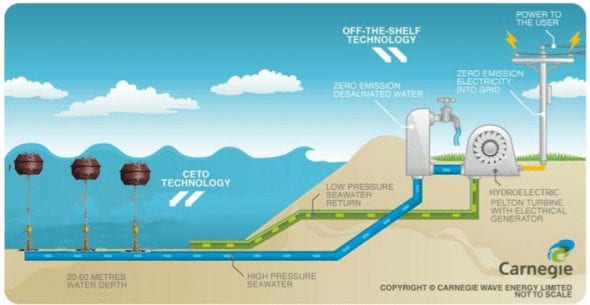Just over one year ago, Carnegie Wave Energy deployed its first commercial-size CETO wave energy machine under the sea off Perth’s Garden Island Naval Base. As Giles Parkinson wrote back then, this represented “a hugely significant moment for Carnegie, which has spent more than a decade developing its 100 per cent owned CETO technology, which has been refined from an original idea from company founder Alan Burns, the oil and mining entrepreneur who became fascinated by ocean energy after being pummelled by some truly big waves in Hawaii and off Rottnest Island nearly two decades ago.”
One year later, and Carnegie is marking another hugely significant moment: A $9.9 million grant from the federal government’s Australian Government’s Emerging Renewables Program (ERP) to support the demonstration and verification of the world’s first grid-connected CETO wave energy project at Garden Island.
Announcing the funding of the Perth Wave Energy Project at Carnegie’s Fremantle HQ on Tuesday, the minister for resources and energy, Martin Ferguson, said that the $9.9 million in federal funds, along with $5.5 million from the WA government, meant the $31 million pilot project could demonstrate the potential for Carnegie’s Australian invented and owned CETO technology to provide up to 2MW of energy to the grid.
“This technology not only has the potential to increase investor confidence in wave projects and help unlock Australia’s untapped wave energy resource, but it could also produce zero emission desalinated seawater, which on a dry continent such as Australia, is a significant additional attraction,” Ferguson said.
In a statement on Tuesday, Carnegie said the grant had allowed its board of directors to approve the location of the wave energy project. It said detailed design would begin immediately and that the company would be seeking all government approvals, and carrying out further community consultation, required for the construction and operation of the project. Construction and commissioning of the project is expected to happen in 2013, with power set to be delivered into the grid by the end of 2013.
Carnegie’s managing director and CEO, Dr Michael Ottaviano, said the federal government support would allow the company to deliver its first revenue generating wave project in its own backyard – a milestone that, once achieved, would unlock a global market opportunity. “There is enormous global demand for a reliable wave energy technology from industry and government alike,” Ottaviano said. “We firmly believe Carnegie and the CETO technology are best positioned to capitalise on that demand.”
Ottaviano also gave a hat tip to Lind Partners, which has worked with Carnegie, helping to oversee operations and, in particular, participating in capital raisings. “The facility allows us to minimise dilution for existing shareholders by raising capital when there is strong share price momentum whilst maintaining maximum capital management flexibility,” Ottaviano said.
So, how will the Perth Wave Energy Project work? Carnegie explains that the facility will consist of an array of submerged CETO units, subsea pipelines to shore, hydraulic conditioning equipment and an onshore power generation facility. Once complete, it offers the potential for later expansion to 5MW.
The CETO units themselves are anchored to the ocean floor, with an attached buoy moving with the waves, driving the pump, which in turn pressurises water that is delivered ashore via a pipeline. This water, in turn, will drive a hydraulic turbine, generating zero-emission electricity. The water can also be used to supply a reverse osmosis desalination plant, replacing the traditional greenhouse gas-emitting electricity driven pumps.
At this small scale, Carnegie says the project itself is not a stand-alone economic investment, but rather aims to demonstrate the successful system engineering, operation and power sales. The company says the PWEP site provides an ideal pre-production test site due to its exposure to open, medium intensity, wave conditions, its immediate proximity to marine support infrastructure and expertise, and security provided by its proximity to Australia’s largest navy base, HMAS Stirling, on Garden Island.









